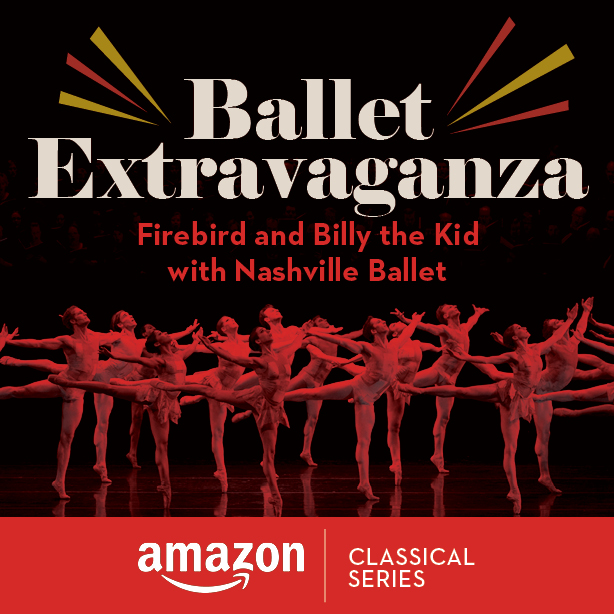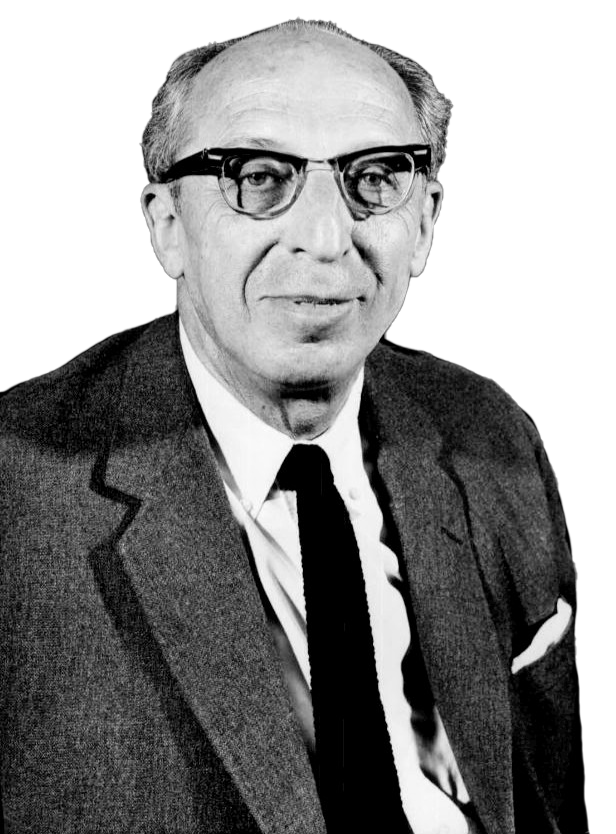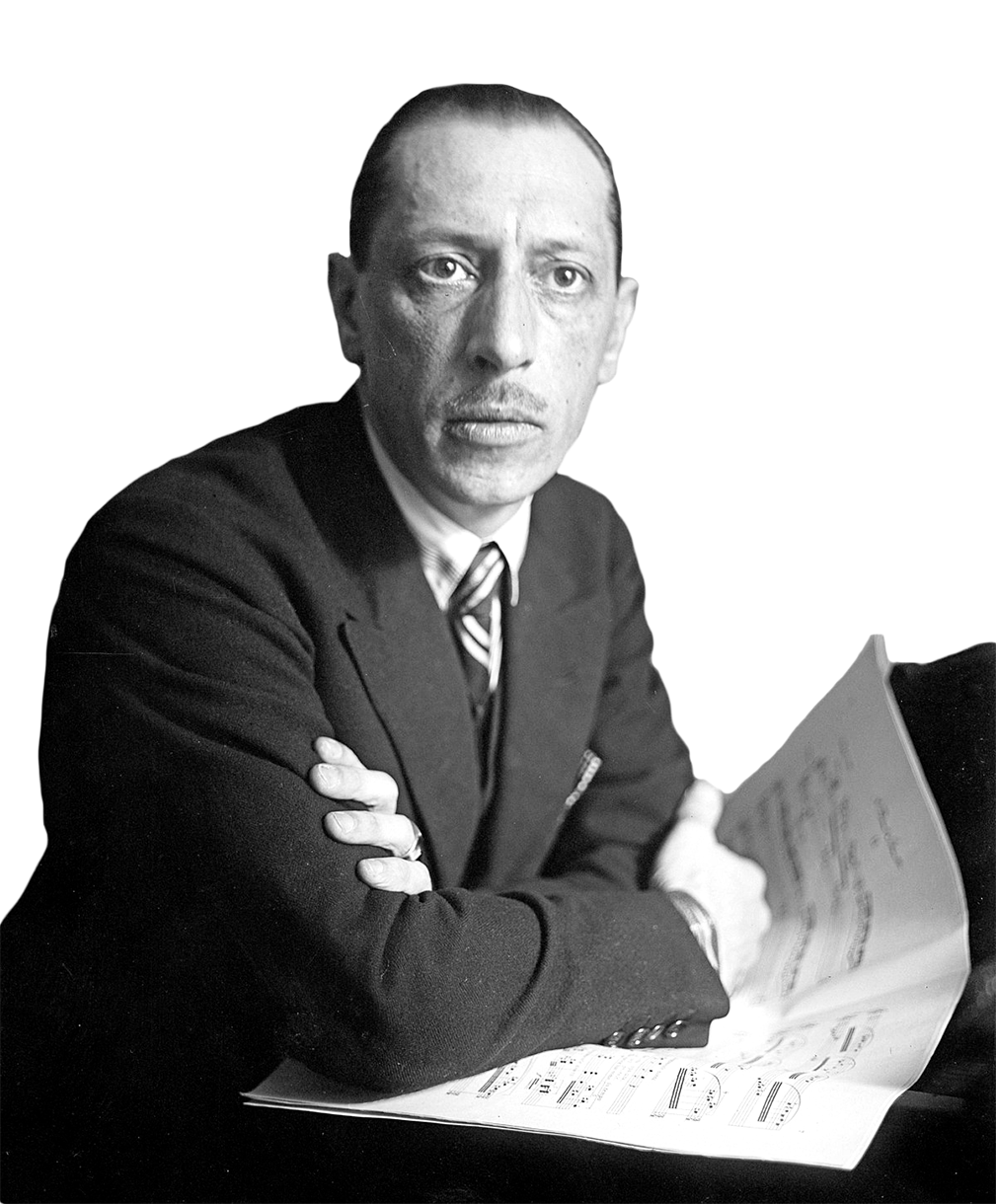
BILLY THE KID SUITE
Conceived and choreographed by Nashville Ballet Artistic Director Paul Vasterling
Ballet performed by members of NB2, Nashville Ballet’s official second company, with Nashville Ballet company dancers Sarah Pierce and Brett Sjoblom
Costumes conceived by Paul Vasterling, created by Mycah Kennedy
Original Lighting Design by Scott Leathers
Notes from Paul Vasterling: “I was inspired by Aaron Copland’s very American score to make a work that explores the idea of “cowboy” in a contemporary context. The music is also just plain fun and elicits movement and dance. The work was created on the youthful exuberance of NB2, Nashville Ballet’s second company, who you see performing tonight.”
Casting
Billie: Sarah Pierce
Cowboy: Noah Miller
Cow-Folk: Justin Abel, Elisabeth Baehman, Annie Bakland, Emily Bailey, Francisco Bermudez, Alyssa Eyster, Jacob Kline, James Lankford, Joshua O’Connor, Autumn Tierney
THE FIREBIRD
Conceived and choreographed by Nashville Ballet Artistic Director Paul Vasterling, inspired by The Firebird composed by Igor Stravinsky
Ballet performed by Nashville Ballet company dancers
Costume Designs by Holly Hynes
Original Lighting Design by Scott Leathers
Notes from Paul Vasterling: “The original ballet of The Firebird is a story about a young prince who encounters a magical bird in a forest. When he becomes caught in a web of evil and all seems lost, the Firebird intercedes. He is introduced to true love by the magical bird and lives on in happiness.
I have re-imagined the ballet, setting it in a time close to now, not with a prince but a sort of everyman who has lost his way and is searching for meaning in his life. He encounters the Firebird, a creature from another world – perhaps an angel, certainly an alien to Earth. He also encounters the Firebird’s opposite, the evil Mr. K (based on the character of Katschei, an evil magician in the original ballet) and his two vile assistants, Miss P and Mr. D. The Firebird helps the Everyman to experience the many forms of love, helps him to conquer the temptation of evil and finally to achieve redemption, bringing him to a place of complete love beyond our world.”
Casting
The Firebird: Claudia Monja*, Lily Saito**
Everyman: Nicolas Scheuer
Mr. K: Owen Thorne
Mr. D: Garritt McCabe
Miss P: Julia Eisen
The Lover: Mollie Sansone
Ensemble: Justin Abel, Annie Bakland, Francisco Bermudez, Celeste Borman, Aeron Buchanan, Michael Burfield, Julia Eisen, Alyssa Eyster, Anneliese Guerin, Emily Ireland-Buczek, Jacob Kline, Jamie Kopit, James Lankford, Isaac Lee, Garritt McCabe, Jaison McClendon, Noah Miller, Joshua O’Connor, Sarah Pierce, Daniel Rodriguez, Imani Sailers, Mollie Sansone, Brett Sjoblom, Raquel Smith, Marissa Stark, Farin Taft, Colette Tilinski, and Jasmine Wheeler
*Thursday and Saturday
**Friday and Sunday
A vast world of difference separates Aaron Copland from Igor Stravinsky, but there are some striking parallels. Both composers changed their musical styles in substantial ways as their careers developed, so that the music from their respective early periods is recognizably different from their later writing. Even more, it was the stimulation of writing for the ballet stage that inspired each to develop a signature style.
For Copland, Billy the Kid paved the way toward the brand for which he is still best recognized: a homespun, lean, emotionally direct kind of music that John Adams likened to “pieces of Shaker furniture, simple to the point of being humble, but sturdy and effective and free of excess emotional baggage.” Billy the Kid is a one-act ballet based on the lore around the notorious outlaw, presenting Billy as a romanticized emblem of the passions and dangers of the Wild West. Copland’s widely spaced harmonies conjure a sense of “the open prairie” and the vast scale of migration westward. He also uses embeds and recomposes bits of famous cowboy tunes, using a kind of montage technique to portray various episodes from Billy’s life.
The Firebird gave Stravinsky his international breakthrough early in the 20th century. The scenario is a stylized version of an old Russian folk-tale merged with a potent symbol from Slavic myth (and, for today’s audiences, echoing motifs familiar from the Harry Potter series). It recounts a good-versus-evil struggle between the noble Prince Ivan and an ogre-like evil wizard who keeps his victims captive. Stravinsky’s dazzlingly colorful score contrasts sonorities evoking the “exotic,” supernatural realm with the simplicity of folk song, the musical symbol of the mortal world. The Firebird remained among his proudest achievements.
 |
|
|
|
|
|
|
|
|
|
|
First performance: The complete ballet was premiered on October 16, 1938, in Chicago by the Ballet Caravan Company, with the music provided by two pianos; the full orchestral version of the ballet was first given on May 24, 1939, in New York City |
|
|
First Nashville Symphony performance: November 13, 1980, with Michael Charry conducting at Andrew Jackson Hall at the Tennessee Performing Arts Center. |
|
In his memoir Hallelujah Junction, the American composer John Adams describes seeing Aaron Copland conduct Appalachian Spring at a Tanglewood concert half a century ago, “his thin Ichabod Crane body jerking awkwardly with the music.” Elsewhere, Adams compares the orchestral music of this pivotal figure to “pieces of Shaker furniture, simple to the point of being humble, but sturdy and effective and free of excess emotional baggage.”
Copland’s best-loved works from the 1930s and 1940s stand out for their simplicity and directness, as embodied in his trio of iconic ballets: Billy the Kid (1938), Rodeo (1942), and Appalachian Spring (1944). But Copland only arrived at this style, for which he is best known, after a period spent studying abroad, in Paris. He experimented with Modernism and so-called “symphonic jazz.” But as the Great Depression lingered, it intensified the desire Copland felt, along with many of his contemporaries, to communicate with a broader audience. Another pragmatic basis for the development of Copland’s forthright style can be found in the contexts for which he was writing. It was largely as part of collaborative projects involving specifically American subject matter, in the genres of ballet, theater, and film, that Copland evolved this style.
Billy the Kid marked a significant breakthrough and paved the way for the later ballets. Within a year of its premiere in 1938, Copland had made his entry into writing film scores as well. The composer remarked that he approached the prospect of creating this “folk-ballet” with “a firm resolve to write simply,” believing that as part of a stage work, “music should play a modest role, helping when help is needed, but never injecting itself as if it were the main business of the evening.”
In the process, Copland produced music that is economical, lean, and at the same time evocative of a vanished American era—whether experienced in its original ballet context or on its own terms as a beloved concert staple. The familiar orchestral Suite extracts about two-thirds of the original ballet score.
The ambitious young impresario Lincoln Kirstein (1907-1996) had proposed the idea of Billy the Kid for his newly formed Ballet Caravan, a touring company that was a forerunner of the New York City Ballet. Playing a sort of American counterpart to Serge Diaghilev, the brilliant, erratic mastermind who got Igor Stravinsky to start writing his pathbreaking ballet scores (starting with The Firebird), Kirstein fixed on Copland as his Stravinsky. The goal was to establish an American ballet distinct from Franco-Russian traditions.
Copland initially took on the scenario for Billy the Kid with some reluctance. The Brooklyn-born and -bred composer sardonically wondered about his own “capabilities as a ‘cowboy composer.’” But the musical possibilities soon fired up his imagination, and he found himself inspired even while summering in the distant milieu of Paris to create the sound world for Billy’s “frontier town.”
WHAT TO LISTEN FOR
Billy the Kid was designed as a one-act ballet based on a semi-fictional treatment of the notorious outlaw, with choreography by Eugene Loring. Born Henry McCarty (1859-1881)—aka William H. Bonney—Billy appears as a quasi-mythical figure, a romanticized emblem of the passions and dangers of the Wild West. Copland frames the story with widely spaced harmonies that vividly conjure a sense of “the open prairie” and its loneliness as well as the vast scale of migration westward. He also uses embeds and recomposes bits of famous cowboy tunes such as “Git Along Little Dogies,” “The Old Chisholm Trail,” and “Goodbye, Old Paint.”
In “Street Scene in a Frontier Town,” the most extensive section of the Suite, we first encounter Billy as a boy of twelve, along with the familiar figures who would populate a Southwestern town. Copland uses a kind of montage technique to suggest the lively scene. (Stravinsky had done something similar for the crowd scenes in his Petrushka of 1911.) For example, he adds unexpected harmonic colorings and clashes of key, and cross-rhythms build excitement until the scene erupts in chaos. A drunken brawl breaks out, interrupting a pair of Mexican women who have been dancing, and Billy’s mother is shot in the crossfire. “In cold fury,” the young Billy “draws a knife from his cowhand’s sheath and stabs his mother’s slayers.”
This sets the pattern for Billy’s criminal career as an adult. The ballet continues with a sequence of representative episodes. “Card Game at Night” establishes a lonely, reflective mood “under the stars.” Violence erupts once more in the percussion-heavy “Gun Battle,” as Billy is ambushed by his former friend-turned-nemesis, Sheriff Pat Garrett. In a local saloon, complete with an out-of-tune piano, a tipsy crowd celebrates the outlaw’s capture.
One of the ballet’s episodes omitted in the Suite dramatizes Billy’s legendary escape from jail into the desert, where he finds refuge with his sweetheart. The Suite cuts to the scene of Billy’s death after he has been caught for the last time. A reorchestrated version of the opening prairie music—anticipating the solemn, proud assurance of Fanfare for the Common Man—is intended, in Copland’s phrase, “to convey the idea of a new dawn breaking.”
Scored for pairs of flutes (with piccolo), oboes, clarinets, and bassoons; 4 horns; 3 trumpets; 3 trombones; tuba; timpani; percussion; harp; piano; and strings.
 |
|
|
|
|
Born on June 17, 1882, in Oranienbaum, Russian Empire; died on April 6, 1971, in New York City |
|
|
|
|
|
First performance: June 25, 1910, in Paris, as part of the Ballets Russes season |
|
|
First Nashville Symphony performance: October 30, 1956, conducted by Guy Taylor at War Memorial Auditorium. |
|
The Firebird marked Igor Stravinsky’s breakthrough to international success when it was premiered a little over a decade later, in 1910, as part of Sergei Diaghilev’s Ballets Russes company season in Paris. The Symbolist-inspired Diaghilev took a major risk by asking a 20-something unknown to write the music for a large-scale ballet. Stravinsky hadn’t even been his first choice but was a backup who turned out to be reliable.
Diaghilev’s strategy was to capitalize on the trendy Parisian fondness for all things Russian. Certainly he had a winning topic in The Firebird, which offers a gorgeously stylized version of an old Russian folk-tale merged with a potent symbol from Slavic myth. The public ate it up, making young Igor into a genuine sensation.
Company member Michel Fokine, who also danced the role of the Prince, concocted the scenario with Alexandre Benois and created the choreography. It was Fokine’s aim “to raise ballet far above the level of pretty divertissement and show that, yes, it could be as substantial as opera,” writes the musicologist Richard Taruskin—but a less expensive type of opera and hence more feasible for the cash-strapped Diaghilev to produce. “The Firebird is ballet d’action raised to a new power. The action was so graphic and detailed—and so natural and realistic—that Fokine dared dispense, in his choreography, with the traditional explanatory gesticulations of conventional mime.”
Diaghilev gave Stravinsky access to a very large ensemble, which allowed the composer to maximally exploit the colorful orchestral wizardry he had learned as a student of Nicolai Rimsky-Korsakov. (In the concert suites we usually hear, Stravinsky pared down his instrumentation.) The Firebird remained among his proudest achievements.
The ballet’s scenario involves a good-versus-evil struggle between the noble young protagonist, Prince Ivan, and an ogre-like figure known as the Immortal Koschei or Kastchei (among the various transliterations of the Russian name), whose victims are liberated when Ivan brings about his downfall.
Ivan’s success, however, is owed to the intervention of the spectacularly enchanting titular bird (sporting one of designer Léon Bakst’s marvelously colorful costumes). Koschei’s wizard-like powers have allegedly made him deathless. The story’s great paradox illustrates how the life-affirming power of the miraculous Firebird (with mythological links to the phoenix) undoes the spell of his immortality, preparing the way for a utopian new dawn.
WHAT TO LISTEN FOR
Stravinsky cleverly juxtaposes music to suggest an “exotic,” supernatural realm—the language associated with the Firebird herself—with the diatonic simplicity of folk song that represents the mortal world. The former relies on an alternative to conventional Western harmony known as the “octatonic” scale (since it takes a combination of eight symmetrically alternating whole and half-steps to divide the octave).
Spooky conjurings low in the strings, at first barely audible, set the scene for Koschei’s magic but illusory garden. These are the grounds where Prince Ivan first encounters the Firebird, whose signature music of shimmering trills and dazzling colors is unmistakable. Ivan captures the creature but spares her life, so in gratitude she gives him a feather to summon her in time of need. (The role, traditionally gendered as female, was created by the great ballerina Tamara Karsavina, though Diaghilev’s star dancer Vaslav Nijinsky himself initially wanted the part.)
The music takes a pastoral turn to depict a group of captive princesses held captive by Koschei as they play with golden apples and perform a ritual folk dance. (Stravinsky later recalled that he conceived the idea for The Rite of Spring while finishing work on The Firebird, though it got set aside in the meantime to take up another Russian-themed story—Petrushka.) Prince Ivan at once falls in love with one of the princesses and determines to free her from Koschei’s spell. The sounds of a magic carillon mark the appearance of Koschei’s guardian monsters and then the ogre himself, who commences to turn the interloper into stone.
This is the point in the ballet when Ivan summons the Firebird, who weaves her own spell that compels the fiends to perform an “Infernal Dance” (shades here indeed of Rite of Spring) marked by violently explosive rhythms. They collapse in exhaustion, and part two of the Firebird’s intervention takes place as they are lulled by a lullaby (first played by the bassoon). She shows Ivan how to vanquish his enemy by destroying a hidden egg that contains his soul (well before the Harry Potter phenomenon).
Koschei’s illusory realm disintegrates into “profound darkness.” The ballet’s short concluding scene begins with a solo horn (associated with Prince Ivan) that heralds liberating sunlight’s arrival and the marriage of Prince Ivan and the Princess. The horn intones a folk melody that is clothed with increasing orchestral splendor, while the Firebird’s complex harmonies come back for a final say in the closing measures.
Scored for a large orchestra of 2 piccolos (2nd doubling as 3rd flute), 2 flutes, 3 oboes, English horn, 3 clarinets (3rd doubling as clarinet in D), bass clarinet, 3 bassoons (3rd doubling as 2nd contrabassoon), contrabassoon, 4 horns, 3 trumpets, 3 trombones, tuba, onstage brass, timpani, percussion, piano, celesta, 3 harps and strings.
